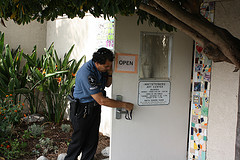Police, Residents Discuss Reasons Behind Watts' Falling Murder Rate

Although Watts still has a crime index 57% higher than the Los Angeles county average, the neighborhood is experiencing a 40-year low in homicide rates. Gang-related homicide rates have fallen from 430 in 1992 to 157 in 2009, a tremendous improvement that has taken a great deal of effort from gang members, LAPD, and the community as a whole.
"The overall crime rate in the area has gone down and the community is a much more safe and open community," said UCLA masters student and Watts native Roberto Rodriguez, "yet there remains a negative view of the community due to the history of crime and poverty that has resulted in a continued deficit view of the community as a whole.”
Riots such as the Watts Riots of 1965 and the Los Angeles Riots of 1992 have “made it very difficult to recover” according to according to Captain Phillip C. Tingirides, LAPD's commanding officer of the South East Area, "because of the resulting in physical destruction, reputational damage, and decreased attractiveness to potential infrastructure projects."
On April 28, 1992, the day before outrage over the Rodney King beating sparked the Los Angeles Riots, something more peaceful and long-lasting occurred: a ceasefire was declared between rival gangs in Watts.
The peace treaty had been in the works for many years. Each of the Watts' housing projects had given birth to a gang of their own, with the Bounty Hunter Bloods originating in Nickerson Gardens, the PJ Watts Crips coming from the Imperial Courts, and the Grape Street Crips emerging from the Jordan Downs project; yet for this, the inter-gang animosity was put aside. Local gangs met outside Nickerson Gardens on April 28, 1992 to put an end to the violence for the sake of their community. The following year, Watts saw a drastic decrease in homicide rates, which inspired gangs throughout the city to follow suit and lay down their guns.
Unfortunately the truce lost much of its sanctity when the younger generation of gang members came of age. Street violence began to escalate and gangs attacked one another for being in their territory.
To some, violence seemed like the only way to make a name for themselves. Other, like Rodriguez, adopted a different perspective. “The negative view of the community becomes internalized within members of the community as a form resistance to attempt to counter the conditions," said Rodriguez, "but as you grow older, for some it becomes a lowered expectation, for others it becomes a reason to overcome the perceived norm.”
“I saw strength and power in recognizing that there were people willing not to accept the norms and build towards a common goal of higher expectations,” he added.
While the gang cease-fire was a major component in the decreased homicide rates, other factors have been at play in helping to improve of the general safety of the area. “My opinion is that reduction in violent crimes is not because of any one source” said Captain Tingirides. “At the crux of it is the relationship built between the police, the gangs, and the community.”
LAPD reports a decline in homicides of more than 60% from 2011 to 2012, falling from 21 to 13 deaths in a year.
Councilman Joe Buscaino attributes the low murder rate to three major factors: the Community Safety Partnership, a cooperative effort between the LAPD and the four public housing developments; the Watts Gang Taskforce, a 7-year tradition of weekly meetings with police, housing representatives, former gang members and other community members to prevent violent outbreaks; and the Gang Reduction Youth Development program, which works to establish safe places for at risk youth and their families to benefit from counseling and other services.
Additionally, LAPD Chief Charlie Beck has played a tremendous role in improving the overall safety in Watts by instituting preventative measures such as has the Urban Peace Academy, a program that trains gang members for entry-level positions in which they can help turn their communities around through education and intervention.
Despite the failure of the 1992 peace treaty, former gang members still remain vital forces in improving the safety of Watts by serving as “peace activists” through these job programs, said Captain Tingirides. He also attributed the growing camaraderie between the LAPD and the community members -- through crime reduction programs and mentoring programs -- as another reason for an increase in safety. Such collaborative programs have made people start to view the authorities as allies rather than enemies. While the number of property crime and thefts reported has gone up, Captain Tingirides believes that this is because people are now reporting issues that had seemed comparatively minor in the past.
Even seemingly minor changes have had tremendous impacts in helping to promote peace.
“The wall at Nickerson had and has a lot to play in it,” said Greg Brown, vice president of the Watts Neighborhood Council, referring to the wall of the recreation center that listed the names of 300 of the project’s victims due to gang violence.
At the heart of the historic violence, gang-related or otherwise, lies the overarching issue of poverty. Low paying job opportunities and high unemployment rates contribute to the sense of desperation that fuels outbreaks of violence throughout low income areas of Los Angeles.
"There still is lots of room for improvement in the community,” said Rodriguez, “but to be honest this is due to the idea that I see a lot of potential in the community."
"I choose to remain a part of my community in order to build up our fellow community members," said Rodriguez. "There must be 'successful' members of our community who work to build up the legacy of higher expectations and the ability to go beyond the low socioeconomic conditions that are present in the community.”



